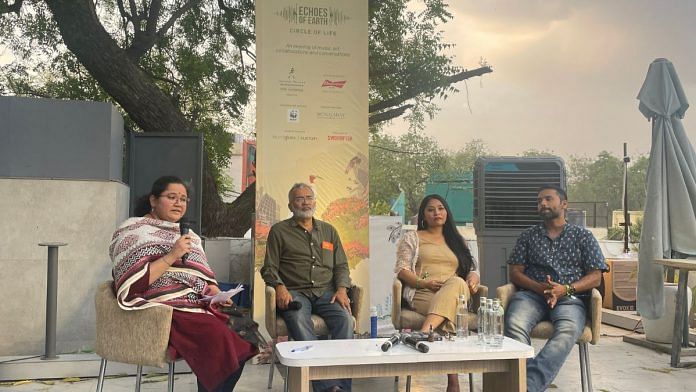New Delhi: A Black Kite peered through the branches of a Semal tree unmoved by the enthusiastic debate on Delhi’s biodiversity that was unfolding below. An Indian Grey Hornbill flew past the audience. On a breezy Sunday evening, panellists and audience members not only pondered over the city’s natural diversity but also experienced it.
‘Echoes of The Earth’, an environment-focused music festival, organised a three-day multi-city series of conservation talks and concerts. The Delhi event was held on 16 April in Mehrauli, near Qutub Minar. Cartoonist and creator of Green Humour comic strip Rohan Chakravarty, Gurgaon-based environmentalist Chetan Agarwal, and conservation biologist and author Neha Sinha got together to delve into Delhi’s urban jungles.
The national capital is a repository of history and nurtures the hopes of migrants from across the country. And it is home to hundreds of species of flora and fauna.
“I lived near the Central Ridge Forest, and so when the sun would go down, I could hear jackals talking to each other and it sounded like laughter,” said Neha Sinha, author of Wild and Wilful. “ Delhi still has jackals and those who live near Jawaharlal Nehru University can still hear them.”
But not everyone would be able to identify a jackal. Chakravarty emphasised the importance of being aware of how nature and biodiversity conserve humans. Knowledge is just as important as being involved in the politics or entertainment of this country, he said.
Sometimes, when he’s invited to a talk, he plays a multimedia game with the audience. He displays photos of Priyanka Chopra, Narendra Modi and a dragonfly on the screen. People easily identify the first two, they can’t quite put their finger on the third.
“Engaging with nature is not just identification, it is simply about understanding how your life is connected to all that is around you. And our lives do revolve around dragonflies just as much as these celebrities. These dragonflies eat mosquitoes and prevent malaria, and people should be more aware of that,” he said.
Pointing up to the sky, Rohan interrupted himself to bring the audience’s attention to the Rosy Starlings flying above their heads. The bird is migrating to India from Europe.
“I’ve been sitting and counting them this whole time and I have noted about 575 now,” he laughed.
Also Read: Delhi-NCR has 7 sprawling biodiversity parks, their economic value is in crores
‘The impulse to protect’
Greed is the biggest threat to biodiversity, said Agarwal.
Having worked extensively in the Aravalli Range, Agarwal explained why the patch of land still rings with noises from forest animals and is abundant with trees.
“This land around Delhi NCR is common land because it was never taken up for private cultivation. It could not be monetised agriculturally which is why it is still home to leopards, hyenas and hundreds of species of birds,” he said.
The government realises this too. Despite Delhi-NCR growing in size and number of people, conservation efforts are constantly underway.
“As land becomes more valuable, regional plans are catching up. Newer plans of conservation for Delhi or for NCR have an impulse to protect the Aravallis and floodplains,” he explained.
Also Read: A leopard walked into Delhi’s Yamuna Park. Then an AAP minister illegally took it out
Our lives are connected
People living in Delhi don’t have to go to the Aravallis to experience biodiversity.
Chakravarty’s favourite spot for nature watching is his balcony, and clearly everywhere else too. “The Indian chat, an endemic bird species, used to be my neighbour,” he said.
Sinha finds a measure of peace in nature in troubled times. She recalled watching Neem trees being graced by various butterflies during the Covid-19 lockdown. Watching those butterflies flutter was a “sight of hope.”
“Even though we were all suffering and dying, the natural world continued as it always has. And so these big trees of Delhi, are this city’s identity for me,” she said.
As a gust of wind brings down yellow leaves on everyone present, the feeling of oneness with nature was only heightened.
From Tesu flowers to the Indian Mongoose — the conversation saw various species of flora and fauna being brought up.
“I love the Semal tree we are sitting under today. It is a major source of nectar for many birds and bats in the city. They all flock to it and it is just like a big party,” said Sinha.
But in the larger scheme of things, with climate change on the rise and rampant oil dumping in oceans, where do we stand as people? That was a question raised by one of the audience members.
The celebratory conversation was suddenly interrupted by the trials of global realities.
“We are still the land of the tiger, the leopard and the cheetah. It is important to know what is at stake, but start in your own garden and develop a personal connection. Try to also find ‘environment’ friendly candidates to vote for,” said Sinha.
(Edited by Theres Sudeep)






